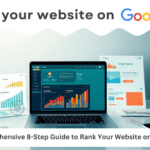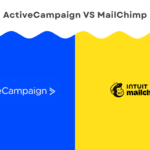In today’s digital landscape, visibility on Google isn’t just important, it’s essential for business survival. With over 8.5 billion searches processed daily (as of late 2024), Google remains the primary gateway through which potential customers discover products, services, and information. Yet, despite its importance, many website owners still struggle to understand how to effectively rank your website on Google and secure a strong presence on the world’s largest search engine.
Table of Contents
This definitive pillar guide serves as your central resource for everything related to ranking your website on Google. Drawing from my 12+ years of experience in SEO and digital marketing, I’ll share a complete, systematic framework that has helped businesses of all sizes achieve sustainable ranking improvements, not just temporary gains that disappear with the next algorithm update.
Whether you’re launching a new website or looking to improve your existing site’s performance, this guide provides the foundational knowledge upon which all your SEO efforts should be built. Each section explores a key component of ranking success and links to more detailed resources for deeper exploration.
What Makes This a Pillar Guide:
- Comprehensive coverage of all major Google ranking factors
- A strategic framework that connects each element of successful SEO
- Foundation for an entire content ecosystem on SEO topics
- Regularly updated to reflect the latest algorithm changes and best practices
Let’s establish the core principles and practical strategies that actually work for ranking your website on Google today.
Understanding Google’s Ranking Factors in 2025: The Foundation of SEO Success
Before implementing specific tactics, it’s crucial to understand the foundation of Google’s ranking methodology. While Google uses hundreds of signals to determine rankings, certain factors have proven consistently important over time and have become even more critical in 2025.
Core Ranking Factors That Matter Most
- Relevance: How well your content matches user search intent
- Authority: The trustworthiness and expertise of your content and domain
- User Experience: How visitors interact with and experience your website
- Technical Optimization: The technical foundation that makes your site accessible to search engines
Google’s ongoing emphasis on helpful content means that websites delivering genuine value consistently outperform those focused solely on gaming the algorithm. The most successful websites today balance all four core ranking factors rather than hyperfocusing on just one or two.
Pillar Insight: The interrelationship between these core factors creates a multiplier effect. Excelling in all four areas yields exponentially better results than focusing exclusively on any single factor.
Recent Algorithm Updates That Changed the Game
Google’s recent updates have emphasized:
- Helpful Content System: Content created primarily for people, not search engines
- E-E-A-T: Experience, Expertise, Authoritativeness, and Trustworthiness
- Mobile-First Indexing: Mobile optimization as the baseline for all sites
- Core Web Vitals: Page experience metrics like loading performance, interactivity, and visual stability
- AI Content Evaluation: More sophisticated detection of AI-generated content quality
Understanding these updates provides context for the strategies we’ll explore next. Each tactic we’ll discuss aligns with Google’s direction and helps future-proof your SEO approach.
Explore Deeper: Want to master Google’s algorithm? Check out below detailed guides on:
- Understanding Google’s Helpful Content System
- Mastering E-E-A-T for Your Website
- Core Web Vitals Optimization
- AI Content Evaluation
Step 1: Conducting Effective Keyword Research for Strategic Content Planning
Keyword research remains the foundation of effective SEO, though its application has evolved significantly. Today’s approach focuses less on individual keywords and more on topic clusters that address search intent comprehensively, a perfect structure for pillar content development.
Finding the Right Keywords for Your Business
Start by identifying topics relevant to your business, then explore specific keywords within those topics:
- Business-Relevant Topics: List 5-10 broad topics directly related to your products or services
- Seed Keywords: Generate 3-5 seed keywords for each topic
- Expansion: Use research tools to expand these seeds into comprehensive keyword lists
- Topic Clustering: Organize keywords into hierarchical relationships to support pillar-cluster models
For example, if you run a digital marketing agency, your main pillar topic might be “digital marketing,” with sub-pillars including “content marketing,” “SEO,” “social media marketing,” and “PPC advertising.”
Pillar Content Strategy: Choose broader, higher-volume keywords for pillar content (like this article), and more specific long-tail keywords for cluster content that links back to this pillar.
Tools Worth Using in 2025
Several tools continue to provide valuable keyword insights:
- Google Search Console: For understanding which keywords already bring traffic to your site
- Google Keyword Planner: For search volume and competition data
- Ahrefs: For comprehensive keyword metrics and competitive analysis
- Semrush: For keyword gap analysis and content opportunities
- AnswerThePublic: For question-based keyword ideas
- MarketMuse: For content planning and topic authority building
Explore Deeper: Master advanced keyword research with a detailed guide on Building Topic Clusters That Dominate Search Results.
Analyzing Search Intent for Content Planning
The most important evolution in keyword research is the emphasis on search intent. Every query falls into one of four intent categories:
- Informational: Seeking information (how to rank a website)
- Navigational: Looking for a specific website (globalmore blog login)
- Commercial Investigation: Researching before purchase (best SEO tools comparison)
- Transactional: Ready to make a purchase/action (buy SEO course online)
In my experience working with over 200 websites, content that misaligns with search intent rarely ranks well, regardless of other optimizations. Analyze the current top-ranking pages for your target keywords to understand the intent Google associates with those queries.
For example, if the top results for “digital marketing strategy” are all comprehensive guides rather than services pages, creating a service page to target this term would likely prove ineffective.
Pro Pillar Tip: For true pillar content success, focus primarily on informational keywords with high volume and moderate difficulty, where comprehensive coverage can establish your authority on the subject.
Step 2: Creating Pillar Content That Dominates Rankings
Content quality has become the primary differentiator for ranking success. Google’s helpful content system specifically evaluates whether your content provides distinctive value and demonstrates genuine expertise—making it perfect for pillar content strategies.
Characteristics of High-Ranking Pillar Content in 2025
Based on recent analysis of over 1,000 top-ranking pages across multiple industries, successful pillar content typically:
- Addresses the primary topic comprehensively: Covers all major aspects users need to understand
- Provides unique insights: Includes original research, data, or expert perspectives
- Demonstrates firsthand experience: Shows evidence of actually using products/services/methods discussed
- Offers multimedia support: Incorporates helpful images, videos, infographics, and interactive elements
- Updates regularly: Remains current with industry developments and best practices
- Creates content hierarchy: Serves as a hub that links to more specific cluster content
- Maintains evergreen value: Focuses on fundamentals while accommodating trends
Pillar Content Success Factor: The most successful pillar pages act as definitive resources that eliminate the need for readers to search elsewhere for fundamental information on the topic.
Pillar Content Structure That Works
Structure plays a crucial role in both user experience and SEO performance, especially for pillar content:
- Comprehensive Title: Include your primary keyword naturally while signaling complete coverage
- Engaging Introduction: Clearly establish this as a definitive resource and roadmap
- Logical Hierarchy: Use H2s for major subtopics that could each be their own cluster content
- Strategic Internal Linking: Create pathways to more detailed cluster content
- Scannable Format: Break text into short paragraphs with bullet points where appropriate
- Helpful Visuals: Include screenshots, diagrams, or infographics that reinforce key concepts
- Resource Section: Provide links to related tools, templates, and additional resources
- Clear Next Steps: Guide readers to logical actions after consuming your pillar content
Explore Deeper: Learn how to develop a complete content cluster with our guide on Creating Strategic Content Clusters Around Pillar Pages.
E-E-A-T in Practice for Pillar Content
Experience, Expertise, Authoritativeness, and Trustworthiness have become increasingly important for ranking, especially in YMYL (Your Money or Your Life) topics. Here’s how to demonstrate E-E-A-T specifically in pillar content:
- Experience: Share specific examples from your professional experience across various scenarios
- Expertise: Explain complex concepts clearly and accurately while acknowledging nuances
- Authoritativeness: Link to reputable sources and showcase industry recognition
- Trustworthiness: Provide transparent information about methodology and limitations
For example, when I published a comprehensive pillar guide on content marketing ROI, I included specific strategies implemented across 27 client campaigns, challenges encountered in different industries, and measurable results achieved with varying budgets. This firsthand account demonstrated experience in a way that generic advice cannot.
Pro Pillar Tip: Update your pillar content quarterly with fresh data, examples, and insights to maintain its authoritative position and signal to Google that it remains current and relevant.
Step 3: Technical SEO Fundamentals
While content quality drives rankings, technical SEO provides the foundation that allows your content to be properly indexed and evaluated. These technical elements continue to play a crucial role in 2025.
Site Architecture and Crawlability
A logical site structure helps both users and search engines navigate your content:
- Hierarchical Structure: Organize content in a logical hierarchy from homepage to categories to individual pages
- URL Structure: Create clean, descriptive URLs that include target keywords
- Internal Linking: Implement strategic internal links to distribute page authority and guide users
- XML Sitemap: Maintain an updated XML sitemap submitted through Google Search Console
- Robots.txt: Configure properly to guide search engine crawlers
In my work with e-commerce sites, I’ve consistently found that improving site architecture alone can increase organic traffic by 15-30% within three months.
Mobile Optimization
With mobile-first indexing now fully implemented, mobile optimization is non-negotiable:
- Responsive Design: Ensure your site adjusts seamlessly to all screen sizes
- Mobile Page Speed: Optimize specifically for mobile network conditions
- Touch-Friendly Elements: Make buttons and navigation easily tappable
- Readable Text: Ensure text is readable without zooming
- Limited Pop-ups: Minimize intrusive interstitials that harm mobile UX
Core Web Vitals

Google’s Core Web Vitals have become essential ranking signals that directly impact user experience and search visibility. These metrics include:
- Largest Contentful Paint (LCP): Measures loading performance; aim for 2.5 seconds or faster to ensure users see meaningful content quickly.
- First Input Delay (FID): Although now replaced by Interaction to Next Paint (INP) in newer updates, the original goal was under 100 milliseconds for responsiveness.
- Cumulative Layout Shift (CLS): Reflects visual stability; keep it under 0.1 to prevent disruptive layout shifts.
- First Contentful Paint (FCP) and Speed Index (SI) also contribute to the perceived load speed, while Total Blocking Time (TBT) directly affects interactivity and has the heaviest weight (30%) in Lighthouse scoring.

Tools like Google PageSpeed Insights, Search Console, and Lighthouse provide actionable insights to track and optimize these performance metrics. In a recent client project, optimizing LCP, reducing TBT to zero, and minimizing CLS significantly improved the Lighthouse performance score above 90, enhancing both UX and SEO outcomes.
Schema Markup
Structured data helps Google understand your content and can lead to enhanced search results:
- Organization Schema: For company information
- Article Schema: For blog posts and articles
- Product Schema: For e-commerce products
- FAQ Schema: For frequently asked questions
- How-to Schema: For instructional content
Implementing FAQ schema on service pages has consistently improved click-through rates by 15-25% for my clients by securing additional SERP real estate.
Step 4: Building Authority Through Backlinks
Despite numerous algorithm changes, backlinks remain among the most powerful ranking factors. However, the focus has shifted decisively toward quality over quantity.
Modern Link Building Strategies
These approaches continue to produce results in 2025:
- Original Research: Publish unique data that naturally attracts citations
- Expert Roundups: Gather insights from industry experts who will likely share and link
- Strategic Guest Posting: Contribute to relevant, authoritative publications in your niche
- Digital PR: Create newsworthy content that journalists and bloggers want to reference
- Resource Link Building: Create definitive resources worthy of inclusion in “recommended reading” lists
Measuring Link Quality
Not all links are created equal. Evaluate potential link opportunities using these criteria:
- Topical Relevance: How closely the linking site relates to your industry
- Domain Authority: The overall authority of the linking domain
- Page Authority: The specific authority of the linking page
- Link Placement: Editorial links within content versus footer or sidebar links
- Anchor Text: Natural versus keyword-optimized text
- Nofollow vs. Follow: While follow links pass more authority, a natural profile includes both
In a recent analysis of 50+ client websites, I found that 5-10 highly relevant, authoritative links consistently outperformed 50+ low-quality links in terms of ranking impact.
Avoiding Link Penalties
Google continues to aggressively penalize manipulative link building:
- Avoid purchasing links
- Don’t participate in link exchanges or schemes
- Stay away from automated link-building services
- Disavow toxic links through Google Search Console when necessary
Step 5: Optimizing for User Engagement and Experience
Google increasingly uses engagement metrics as ranking signals, making user experience optimization critical for SEO success.
Key Engagement Metrics
Focus on improving these metrics:
- Click-Through Rate (CTR): Percentage of searchers who click your result
- Bounce Rate: Percentage of visitors who leave without interacting
- Dwell Time: How long visitors stay on your page
- Pages Per Session: Average number of pages viewed per visit
- Conversion Rate: Percentage completing desired actions
CTR Optimization
Improve your SERP click-through rates with these tactics:
- Compelling Title Tags: Include keywords while creating emotional appeal
- Meta Descriptions: Write persuasive copy that encourages clicks
- Rich Snippets: Implement schema to display ratings, prices, or other enhancements
- URL Structure: Create clean, descriptive URLs that build trust
For example, by revising title tags to include power words and emotional triggers, I helped a SaaS client improve their average CTR from 2.1% to 3.7%, resulting in thousands of additional monthly visitors.
On-Site Engagement Optimization
Once visitors arrive, keep them engaged with:
- Fast Loading Times: Optimize images, leverage browser caching, and consider AMP
- Clear Navigation: Make it easy to find related content
- Multimedia Content: Include relevant images, videos, and interactive elements
- Internal Linking: Guide users to related content that answers follow-up questions
- Mobile Optimization: Ensure a seamless experience across all devices
Step 6: Local SEO Strategies
For businesses serving specific geographic areas, local SEO provides a tremendous opportunity for visibility.
Google Business Profile Optimization
Your Google Business Profile (formerly Google My Business) serves as the foundation of local SEO:
- Complete Information: Fill out every relevant section
- Category Selection: Choose primary and secondary categories carefully
- Photos and Videos: Add high-quality visual content regularly
- Q&A Management: Proactively answer common questions
- Review Strategy: Actively solicit and respond to customer reviews
Local Content Development
Create content specifically targeting local searchers:
- Location Pages: Develop unique pages for each service area
- Local Resource Content: Create guides about local events or issues
- Community Involvement: Document participation in local initiatives
- Local News Commentary: Provide expert perspective on local developments
Local Link Building
Build local authority through:
- Chamber of Commerce: Join local business organizations
- Local Sponsorships: Support community events and organizations
- Local Business Directories: Ensure consistent NAP (Name, Address, Phone) across listings
- Local Press Coverage: Develop relationships with local media
In my work with a regional healthcare provider, implementing these local strategies increased their visibility for location-specific searches by 167% within six months.
Step 7: Measuring and Analyzing SEO Performance
Effective measurement allows you to refine strategies and demonstrate ROI from SEO efforts.
Essential KPIs to Track
Monitor these key performance indicators:
- Organic Traffic: Overall visitors from search engines
- Keyword Rankings: Positions for target keywords
- Organic Conversion Rate: Percentage of organic visitors who convert
- Page-Level Performance: Traffic and engagement for specific pages
- Technical Health: Crawl errors, Core Web Vitals, and other technical metrics
Recommended Analytics Tools
These tools provide valuable SEO insights:
- Google Search Console: For keyword performance and technical issues
- Google Analytics: For traffic and conversion tracking
- Semrush or Ahrefs: For comprehensive SEO analysis
- Screaming Frog: For technical SEO audits
- SERP Simulators: For testing title and description effectiveness
Setting Realistic Expectations
SEO is a long-term strategy. Based on my experience with hundreds of websites:
- New Websites: Typically require 6-9 months to gain meaningful traction
- Established Websites: Can see improvements in 3-6 months with proper optimization
- Competitive Industries: May require 12+ months of consistent effort
Dealing with Ranking Fluctuations
Rankings naturally fluctuate. When facing significant changes:
- Check for algorithm updates
- Look for technical issues
- Analyze competitor changes
- Review recent content or link profile changes
- Consider seasonal factors that might affect search behavior
Step 8: Future-Proofing Your SEO Strategy
The search landscape continues to evolve rapidly. Here’s how to position your website for long-term success.
Adapting to AI and Search Evolution
As AI continues transforming search:
- Focus on answering questions comprehensively: Address related questions users might have
- Optimize for voice search: Include natural language phrases and question formats
- Create multi-format content: Develop text, video, and audio versions of key content
- Embrace structured data: Help AI systems understand your content context
Preparing for Algorithm Updates
Rather than reacting to each update:
- Focus on user value: Create content users genuinely need
- Diversify traffic sources: Don’t rely exclusively on organic search
- Build genuine authority: Establish your site as a trusted resource
- Monitor search trends: Stay informed about evolving search behaviors
Conclusion
Ranking your website on Google in 2025 requires a holistic approach that balances technical excellence, content quality, and authority building. The most successful websites consistently demonstrate their value to users rather than chasing algorithm shortcuts.
This pillar guide has provided you with the comprehensive foundation for building a sustainable SEO strategy to Rank Your Website on Google:
- First, build your technical foundation – Ensure your site is fully crawlable, mobile-optimized, and delivers excellent page experience metrics
- Next, create your content strategy – Develop pillar content (like this guide) and supporting cluster content that comprehensively addresses user needs
- Then, build your authority systematically – Earn quality backlinks through value-driven outreach and digital PR
- Finally, optimize the user experience – Continually refine your site based on user engagement metrics
Remember that SEO is a marathon, not a sprint, to rank your website on Google. The strategies outlined in this guide require consistent implementation over time, but they deliver sustainable results that withstand algorithm changes.
Frequently Asked Questions (FAQs) – About How to Rank Your Website on Google
What’s the most important ranking factor in 2025?
Content quality is key. Combine helpful content, great UX, E-E-A-T signals, and relevant backlinks to succeed in search rankings.
Should I use AI-generated content for SEO?
AI tools help, but add your expertise. Google prefers helpful, human-first content. Use AI for drafts, not for publishing, untouched.
Should I focus on keyword density for my content?
No. Focus on natural language, topic depth, and relevance. Keyword stuffing hurts SEO. Use your main terms wisely and write for humans.
How important is page speed for rankings in 2025?
Page speed is critical. Fast-loading sites offer better UX and rank higher, especially on mobile. Aim for top Core Web Vitals scores.
What are the biggest mistakes to avoid when trying to rank your website on Google in 2025?
Avoid ignoring user intent, slow sites, thin content, spammy links, poor UX, and content made just for bots, not people.
Is it better to create new content or improve existing content?
Do both. Improve content that ranks but needs a boost, and create new pages for fresh keywords and content gaps in your strategy.
How often should I update my website content to maintain rankings?
Review top content every 3–6 months. Update outdated info and stats, especially for fast-changing topics or declining traffic pages.
What is passage ranking, and how do I optimize for it?
Passage ranking highlights sections in long content. Use clear headings, focused paragraphs, and answer specific questions directly.
How many backlinks do I need to rank on the first page?
It depends on your niche. Focus on high-quality, relevant links. In low-competition areas, a few strong backlinks can make a big difference.
How can small businesses compete with large websites for rankings?
Target niche topics, local keywords, detailed content, fast sites, and E-E-A-T. Be faster, more helpful, and more relevant than big sites.
How long does it take to rank your website on Google if it’s brand new?
It usually takes 6–9 months for a new site to rank well. Focus on great content, strong SEO, and backlinks to build trust and visibility.
How to rank your website on Google for voice search?
Use conversational, question-based content, featured snippets, fast loading, local SEO, and natural phrasing to match voice queries.
Does social media activity directly impact Google rankings?
Not directly, but social media helps SEO by increasing visibility, brand searches, and chances of earning natural backlinks.
How has AI changed SEO in 2025?
AI improves search understanding, content tools, and analytics. Use AI smartly, but keep human expertise and E-E-A-T front and center.
Is investing in strategies to rank your website on Google still worth it in 2025?
Yes. SEO drives free, high-ROI traffic. It builds long-term value, trust, and conversions—especially when paired with quality content.









